Journey into the biblical cosmos to uncover Saturn's veiled role and its profound impact on ancient interpretations—discover what lies beneath.
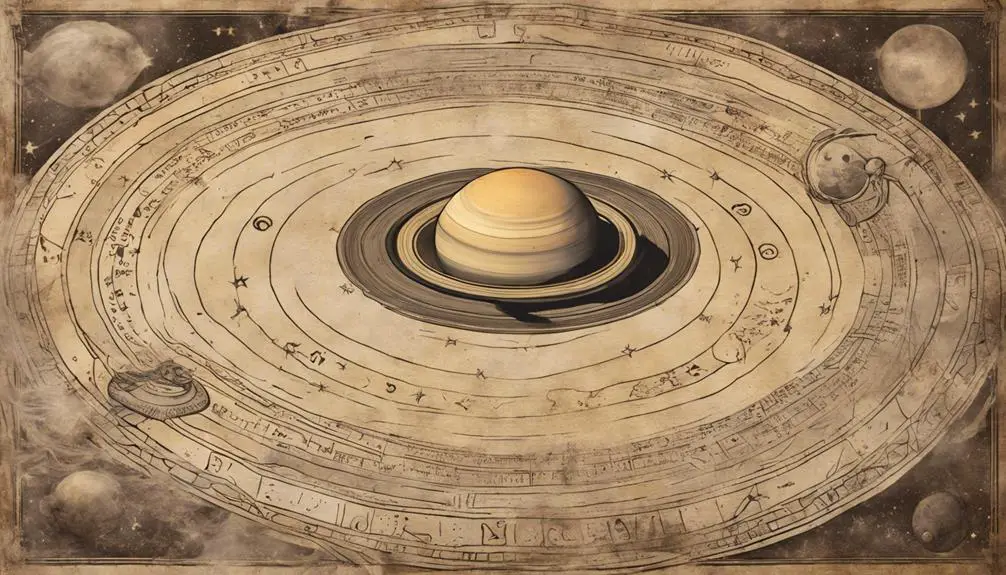
Saturn in the Bible
You may not be aware that Saturn holds a unique, albeit veiled, place within the biblical narrative, intertwining with ancient beliefs and celestial symbolism. As you explore its historical context and astrological significance, you'll uncover how Saturn's imagery permeates ancient texts, including the Bible, revealing layers of meaning that have influenced interpretations and scholarly discussions for centuries.
The connection between Saturn and the Sabbath, along with its role in prophecy, offers a fascinating glimpse into how celestial bodies were woven into the fabric of spiritual and cultural life. This journey invites you to uncover how scholars view these celestial imageries and their impact on our understanding of biblical passages.
Key Takeaways
- Saturn is not directly mentioned in the Bible, but its symbolism influences biblical interpretations.
- Biblical references to celestial bodies, including planets, are often metaphorical, symbolizing time, change, or divine intervention.
- Scholars explore indirect connections between Saturn and biblical texts, analyzing its symbolic role in prophecies and narratives.
- Understanding Saturn's biblical significance requires examining cultural and historical contexts, beyond literal celestial observations.
Historical Context and Astrology
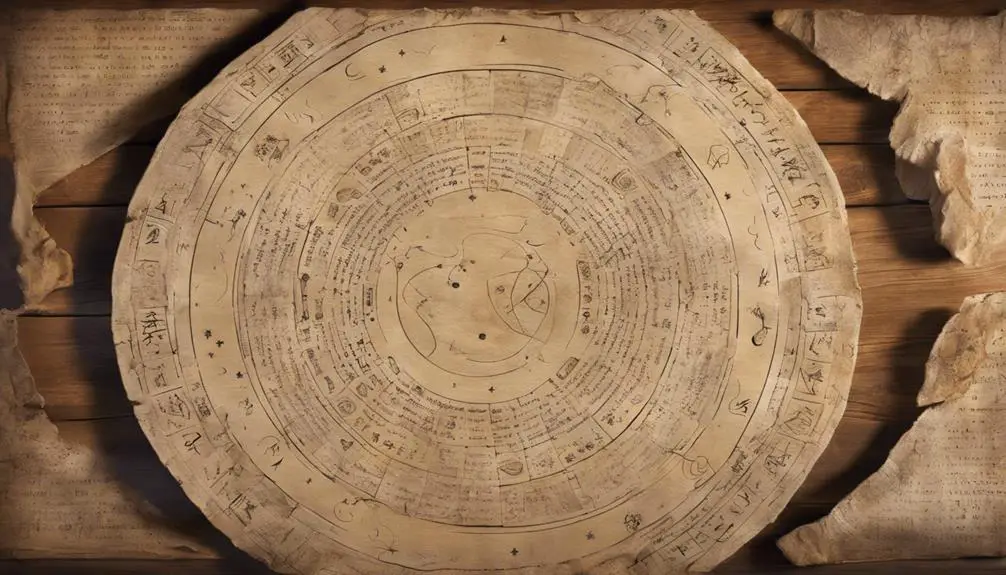
Delving into the historical context and astrology, it's essential to understand how Saturn's symbolism and significance have evolved over time, influencing both ancient beliefs and biblical interpretations. Originating from Roman mythology, Saturn was more than just a celestial body; it was a powerful deity associated with time, harvest, and dissolution. This multifaceted character of Saturn in mythology laid a complex foundation for its perception in various cultures, including those who wrote and interpreted the Bible.
In Roman mythology, Saturn was revered and feared, embodying both the bountiful harvest and the inevitable decay that follows. This duality mirrors the biblical themes of creation and apocalypse, suggesting a nuanced understanding of Saturn's influence on early biblical thought.
As you delve deeper, modern astronomy offers a stark contrast to these ancient interpretations, viewing Saturn not as a god but as a planet with distinctive rings, a symbol of the advances in human understanding and technology. Yet, despite these scientific advancements, the symbolic weight of Saturn, inherited from ancient times, continues to echo in contemporary interpretations of biblical texts. This blend of ancient symbolism and modern discovery underscores the evolving relationship between humanity and the cosmos, bridging past beliefs with present knowledge.
Saturn's Symbolism in Ancient Texts
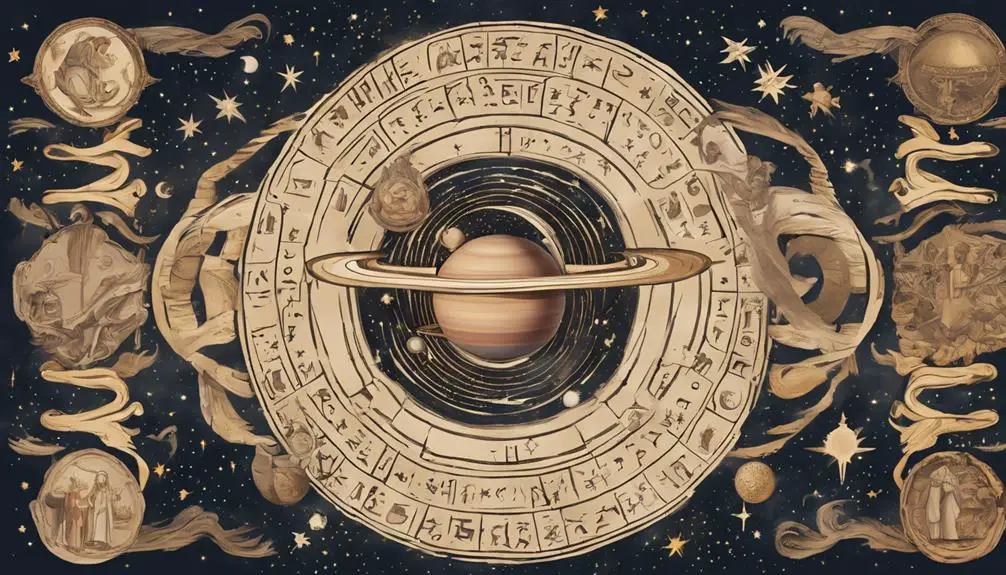
Exploring Saturn's symbolism in ancient texts, we encounter a rich tapestry of meanings that extend beyond its physical manifestation in the night sky, revealing a profound connection between celestial observations and human culture. Saturn, named after the Roman god of agriculture and time, held a pivotal role in reflecting societal values and practices, especially in relation to Roman festivals and agricultural cycles.
Aspect |
Symbolism in Ancient Texts |
Connection to Society |
|---|---|---|
Saturn the Planet |
Time, change, and renewal |
Reflection on life's cycles |
Roman God Saturn |
Agriculture, wealth, liberation |
Basis for festivals, social structure |
Festivals |
Saturnalia, sowing rituals |
Celebration, social order, and agricultural planning |
These elements combined to form a complex symbol that was integral to the way ancient civilizations understood and organized their world. You'll find that Saturn's influence went beyond mere celestial observation; it was a cornerstone in the foundation of ancient calendars, guiding agricultural practices and societal festivities. The alignment of Roman festivals with Saturn's cycles illustrates a deep symbiotic relationship between the heavens and human activity, highlighting how celestial movements were woven into the very fabric of ancient life, guiding both practical agricultural cycles and spiritual reflections within the community.
Biblical Passages and Interpretations

Turning to the Bible, one finds that references to Saturn are notably absent, compelling scholars to seek indirect connections through symbolic interpretations and the broader context of ancient Near Eastern astronomy. You'll discover that analyzing biblical texts for celestial bodies involves a delicate balance between historical context and symbolic meaning, often leading to planetary misinterpretations.
- *Cultural discrepancies* play a significant role in understanding biblical references, as the ancient Hebrews mightn't have viewed celestial bodies in the same manner as their neighbors.
- Biblical authors used stars and planets metaphorically, without specific identifications, leading to debates among modern scholars.
- The Book of Amos (5:26) and Acts (7:43) mention 'Chiun' and 'Rephan,' which some associate with Saturn, but interpretations vary widely.
- Ancient texts outside the Bible provide context for how Near Eastern cultures viewed Saturn, offering clues but also complicating direct biblical connections.
- The lack of explicit mentions of Saturn invites a broader analysis of how biblical texts engage with contemporary astronomical knowledge, avoiding simplistic readings.
Understanding these aspects demands a nuanced approach, acknowledging both the richness of biblical literature and the complexities of ancient astronomical knowledge.
The Role of Planets in Prophecy
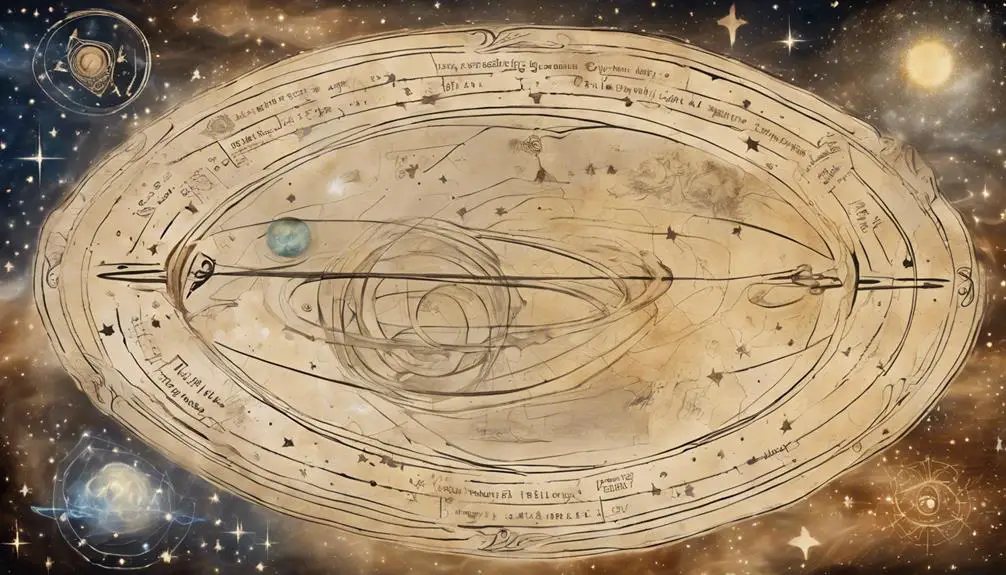
Reflecting on the nuanced interpretations of celestial bodies in biblical texts, it's crucial to examine the role of planets in prophecy to fully appreciate their significance within this ancient literary and cultural framework. The movements and positions of planets, including Saturn, have been historically interpreted as omens or signs of future events, intertwining with the fabric of prophecy. This intertwining showcases a fascinating blend of astronomy and theology, offering a unique lens through which to view the biblical narrative.
Modern astronomy has significantly advanced our understanding of the cosmos, bringing into question the accuracy of ancient prophecies based on celestial observations. However, when you delve into the context in which these prophecies were made, you'll find that they often embody a deeper symbolism rather than a direct forecasting based on planetary positions. The accuracy of prophecy, then, becomes a matter of interpreting the symbolic language rather than a straightforward astronomical prediction.
This analytical approach allows you to appreciate the role of planets in biblical prophecy not as literal predictors of the future but as symbolic elements within a complex theological and literary tradition. Understanding this context is essential for a nuanced appreciation of the prophetic texts and their enduring impact.
Saturn and the Sabbath Connection
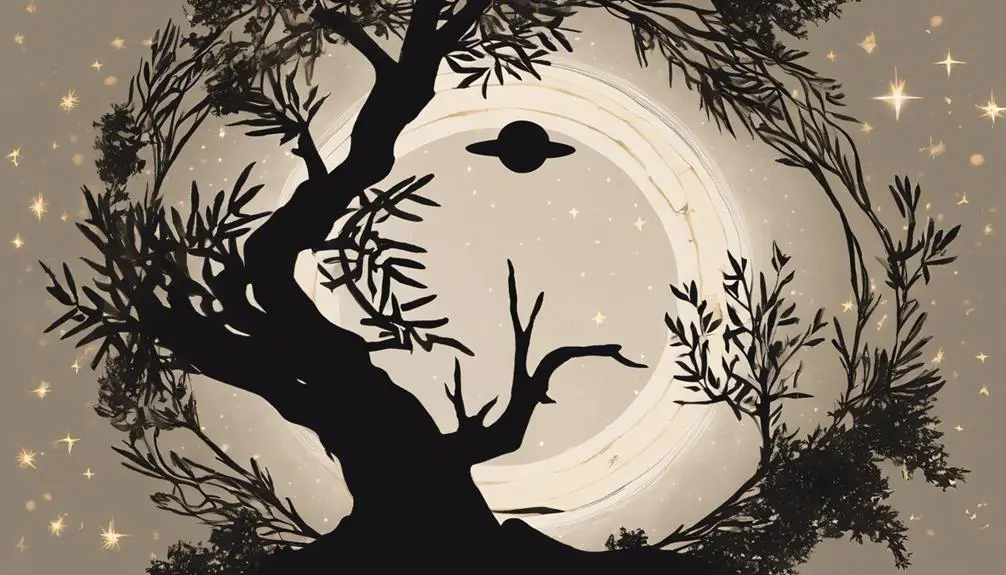
Delving into the connection between Saturn and the Sabbath reveals a complex interplay of celestial symbolism and religious observance within biblical texts. This relationship is deeply rooted in historical contexts, particularly in how ancient civilizations understood time and divinity. The Roman calendar and agricultural rituals offer a lens through which one can explore this connection, suggesting that the cyclical nature of both celestial movements and agricultural seasons profoundly influenced religious practices.
- Roman Calendar: The Romans named Saturday after Saturn (Saturni dies), which aligns with the Jewish Sabbath, hinting at a shared cultural emphasis on cycles of rest and worship.
- Agricultural Rituals: Saturn, the god of agriculture, underscores the link between the timing of religious observances and the cycles of planting and harvesting.
- Weekly Rest: The concept of a day of rest, inspired by Saturn's association with renewal and fertility, mirrors the Sabbath's role as a time for reflection and rejuvenation.
- Cultural Syncretism: The blending of Roman and Jewish traditions might've influenced the alignment of Saturn's day with the Sabbath.
- Historical Context: Understanding the Sabbath within the framework of Roman influence and agricultural cycles offers insights into its origins and development.
Analyzing these facets underscores the Sabbath's multifaceted origins, blending celestial symbolism with earthly cycles.
Scholarly Views on Celestial Imagery

Throughout history, scholars have debated the significance of celestial imagery in biblical texts, examining its impact on ancient religious practices and beliefs. You've likely noticed that stars, planets, and other celestial bodies aren't just background elements in these sacred texts; they're woven into the very fabric of the stories, carrying deep symbolic meanings.
Modern interpretations of these symbols have evolved, shedding light on how ancient cultures perceived the universe and their place within it.
These celestial markers aren't mere decorations. They serve as metaphors for divine intervention, markers of time, and symbols of prophecy. Scholars argue that understanding these cultural representations is crucial for a deeper comprehension of the biblical narrative. For instance, Saturn's appearances in biblical texts mightn't just be literal references to the planet but could symbolize broader concepts of time, change, or judgement within these ancient texts.
As you delve deeper into these scholarly views, you'll find that celestial imagery in the Bible is a rich tapestry of meaning, intertwined with the beliefs and knowledge of ancient societies. It's a fascinating blend of astronomy, theology, and cultural history, offering insight into how humanity has looked to the skies to understand its place in the cosmos.
Frequently Asked Questions
How Do Modern Religious Leaders Interpret the Significance of Saturn in Relation to Contemporary Spiritual Practices?
You'll find that modern religious leaders interpret Saturn's symbolism in diverse ways, integrating it into contemporary spiritual practices through planetary theology.
They often analyze Saturn's roles and meanings, linking them to themes of time, discipline, and trials.
This approach enriches their teachings, offering a nuanced perspective that blends ancient wisdom with modern insights.
Are There Any Specific Rituals or Traditions in Christianity Today That Can Be Directly Linked to Saturn's Influences or Characteristics?
You're diving into a complex topic, looking for Christianity's ties to Saturn's traits.
Interestingly, no direct rituals or traditions in Christianity today stem from Saturn's influences. Yet, the shadow of ancient Saturnalia celebrations lingers, subtly influencing festivities like Christmas.
Analyzing planetary symbolism, it's clear: though Christianity doesn't overtly adopt Saturn's characteristics, the planet's historical and cultural significance subtly permeates religious observances, without a formal acknowledgment within the faith's contemporary practices.
How Do Different Denominations Within Christianity View the Astrological Aspects of Saturn Differently?
You'll find that within Christianity, denominations differ significantly in their views on Saturn's astrological aspects.
Some see Saturn symbolism as irrelevant, dismissing planetary interpretations in a religious context.
Others, however, may draw on historical or symbolic connections, analyzing Saturn's characteristics for deeper spiritual meanings.
The variance largely stems from how each tradition values astrology's role in faith, with interpretations ranging from metaphorical lessons to outright skepticism.
Can the Influence of Saturn Be Seen in Christian Architecture or Iconography Outside of the Biblical Text?
When you delve into architectural analysis, you'll find that Saturn symbolism isn't overtly present in Christian architecture or iconography. This absence is notable because, despite the rich symbolic language in these realms, they primarily draw from Christian narratives and theological themes rather than astrological ones.
However, a nuanced examination might reveal subtle influences or parallels, suggesting that the impact of Saturn, if any, is embedded in more abstract or allegorical forms rather than explicit representations.
How Has the Perception of Saturn in the Bible Influenced Interfaith Dialogues or the Understanding of Christianity in Relation to Other World Religions?
Diving into the cosmic pool of interfaith myths, you'll find Saturn's symbolism sparking dialogue. It's like a celestial bridge, connecting Christianity to other world faiths.
Analyzing how Saturn's narrative weaves through religious texts reveals a tapestry of shared stories and beliefs. This not only enriches the understanding of Christianity's place in the world's spiritual mosaic but also encourages a deeper, scholarly appreciation of the interconnectedness of global religious traditions.
Conclusion
As you've journeyed through the celestial imagery of the Bible, it's striking how Saturn's symbolism weaves into the fabric of ancient texts, echoing in the silent halls of history.
Coincidentally, like Saturn's own rings, these interpretations circle back, enriching our understanding of prophecy and the Sabbath. Scholars peel back layers, revealing connections that, while once obscured, now shine as brightly as Saturn in the night sky.
This exploration not only enlightens but also connects us to the cosmic dance of our ancestors.



Sign up